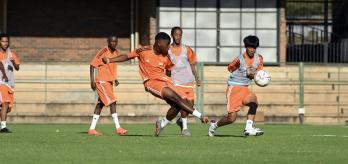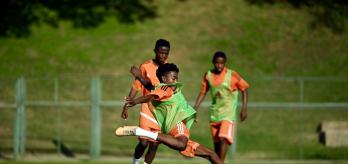Methodology
The intention: What is practised?
This finishing drill works on feints and other body movements that help an attacker to evade the attentions of a defender and to work an angle for a shot after receiving the ball along the edge of the penalty area. The exercise focuses on player-level aspects, such as making subtle body movements that may include faking to shoot, performing double movements and darting into space to get away from a marker. When in wide positions, attackers should pull away from the defender before receiving the ball and then open their body up to face the goal, which should enable them to move towards goal more quickly and to work the space to shoot. When in central areas, attackers should make subtle, deceptive movements to confuse the defender and open up some space to take a touch into.
The scale: For whom is this relevant?
This exercise revolves around the player and focuses on their ability to lose their marker and to finish on goal from various positions inside the penalty area. The drill is particularly relevant to attacking players and to scenarios in which an attacker receives the ball on the edge of the penalty area and has work to do to beat their defender before shooting. The exercise focuses on two specific scenarios in which an attacker receives the ball on the edge of the penalty area: a) between a full-back and a centre-back, and b) with their back to goal with a defender applying pressure from behind.
The practice type: How is the practice designed?
This exercise, which features three finishing stations, aims to improve players’ finishing ability from various angles. A defender provides opposition, and whilst they only apply light pressure, their presence forces the attacker to pay attention to their touch and to recognise how to orientate their body to maintain a positional advantage. The mannequins provide a reference point, and attackers should pull away from them to gain space in between defenders before receiving the ball. The exercise set-up in terms of the distance from and the angle towards the goal mean that time and spatial restrictions apply, with attackers tasked with working some space and shooting quickly.
Session plan
Organisation
-
Position a full-size goal at one end of the exercise area and place a goalkeeper in the goal.
-
Set up a station comprising a mannequin and 3 cones either side of and several metres from the points where the penalty arc intersects with the penalty area, as displayed in the graphic above.
-
Set up a central station comprising 3 cones positioned in line with the midpoint of the penalty arc, as displayed in the graphic above.
-
Position attackers and servers (oranges) and defenders (blues) at the relevant cones, as displayed in the graphic above.
Explanation
-
The exercise starts with the player occupying server cone 1 in possession.
-
They pass the ball into the attacker at their station, who makes a short darting run away from the mannequin to take up a position approximately level with the passer.
-
Once they receive the ball, the attacker dribbles towards goal and aims to shoot quickly.
-
As soon as the attacker receives the ball, the defender closes them down and defends passively throughout the sequence.
-
The sequence then moves to the central station, with the server passing the ball to the attacker, who turns and tries to beat the passive defender before shooting.
-
The sequence is then repeated on the opposite side of the penalty area, starting at server cone 3.
-
Rotate the players between stations and ensure that the defenders and attackers swap roles to enable all players to practise all scenarios.
Key coaching points
Roles of coaches
-
First coach: coaches the attackers at the middle station.
-
Second coach: coaches the attackers at the right station.
-
Third coach: coaches the attackers at the left station.





















































